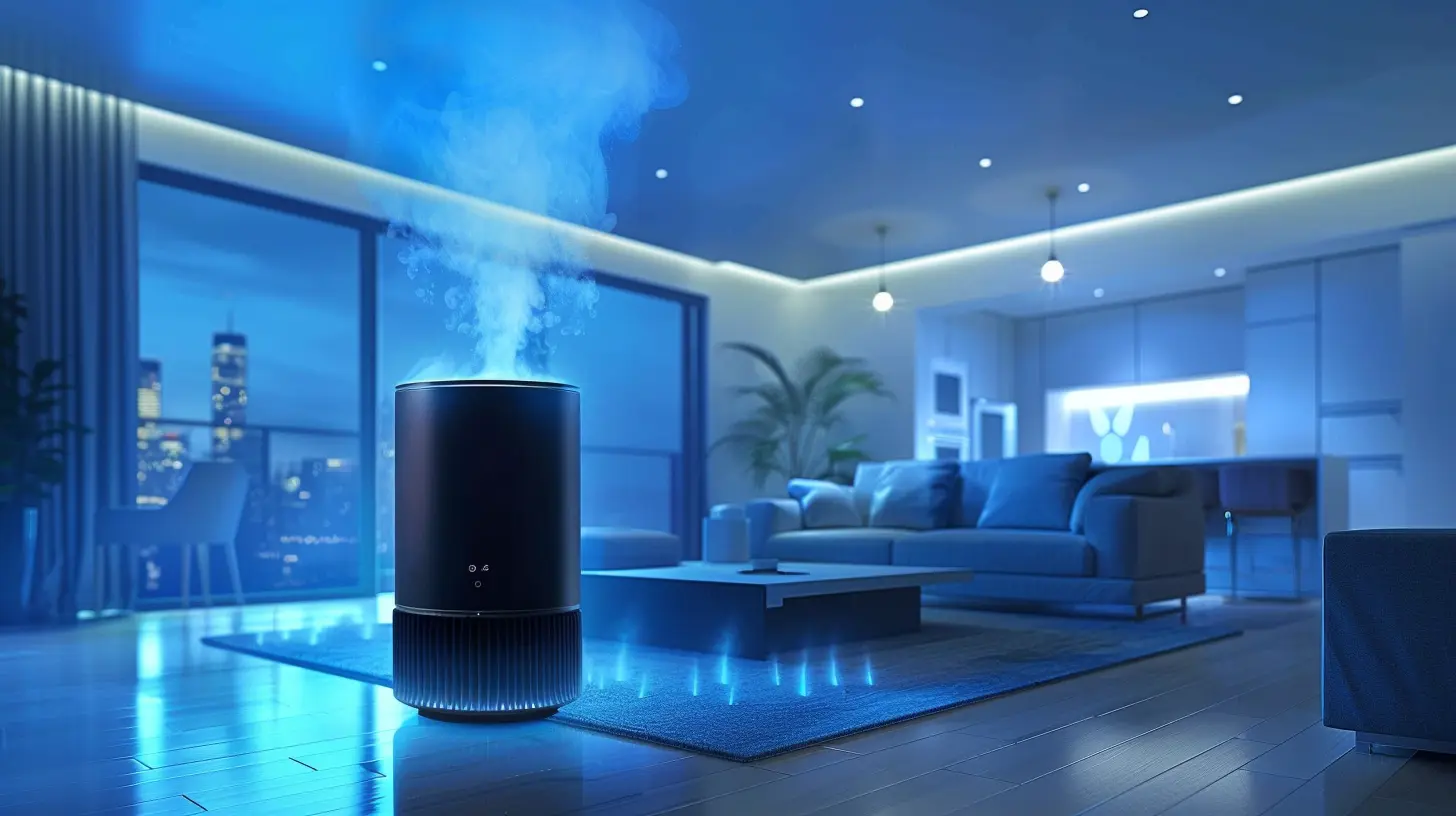Smart Air Purifiers: Breathing Easy with Connected Technology
22 November 2024
In today’s fast-paced world, we're constantly looking for ways to improve our health and well-being. Among the various gadgets designed to make life better, smart air purifiers stand out. These devices have evolved from simple air-cleaning machines to sophisticated, connected tools that provide us with cleaner air and much-needed peace of mind.
But what exactly are smart air purifiers, and how do they differ from traditional ones? Why should you consider getting one for your home? Stick around, and we’ll dive into everything you need to know about smart air purifiers, from how they work to the benefits they bring. By the end of this article, you’ll be breathing easier—literally.

What Are Smart Air Purifiers?
Let’s start with the basics. Air purifiers, in general, are devices that clean the air by trapping pollutants such as dust, pollen, pet dander, smoke, and even harmful fumes from cleaning products. They use filters, UV lights, or ionizers to remove these impurities, leaving fresher, cleaner air behind.Now, throw some "smarts" into the mix, and you’ve got a smart air purifier. These are air purifiers with added intelligence, meaning they’re connected to your smartphone or home automation system via Wi-Fi or Bluetooth. Beyond just purifying air, they monitor air quality in real-time, give you updates, and allow you to control them remotely.
Imagine being able to turn on your air purifier before you even walk through the door or getting a notification when the air quality dips. Smart air purifiers take the guesswork out of maintaining a healthy indoor environment.

How Do Smart Air Purifiers Work?
At their core, smart air purifiers still use traditional filtering methods to clean the air. Most come with a multi-stage filtration system that typically includes:- Pre-Filters: These trap larger particles like dust and pet hair.
- HEPA Filters: HEPA (High-Efficiency Particulate Air) filters are the gold standard, capturing up to 99.97% of particles as small as 0.3 microns.
- Activated Carbon Filters: These are used to neutralize odors and harmful gases.
- Optional UV Lights or Ionizers: Some models also use UV light to kill bacteria and viruses or ionizers to bind particles together, making them easier to trap.
But what makes them "smart" is their ability to connect to your network and provide real-time data. Equipped with sensors, these purifiers can detect changes in air quality and adjust their settings automatically. You can control everything from fan speed to operating modes through an app on your smartphone, giving you more control over your indoor environment.
Most smart air purifiers also offer compatibility with popular voice assistants like Amazon Alexa and Google Assistant. This means you can simply ask your smart speaker to turn the purifier on or off, change the mode, or check the air quality without lifting a finger.

Why Should You Consider a Smart Air Purifier?
Now, you might be wondering, "Why should I upgrade to a smart air purifier when traditional ones work just fine?" Well, it all comes down to the extras. Let’s break down the key benefits of choosing a smart system over a standard one.1. Real-Time Air Quality Monitoring
One of the most compelling features of smart air purifiers is their ability to monitor air quality in real-time. Many come with built-in sensors that detect pollutants, allergens, and even humidity levels. The purifier then communicates this information to your smartphone, giving you up-to-the-minute reports on the air you’re breathing.Think about it: you never have to guess whether or not your air quality is poor. The purifier will tell you. Plus, some models even recommend actions, such as opening a window or turning on the purifier to full blast when the air quality dips.
2. Remote Control
We live in a world where convenience is king. The ability to control your air purifier from anywhere is a game-changer. Whether you’re at work, on vacation, or simply too comfortable on the couch, you can adjust your air purifier's settings via a mobile app.This is especially useful if you want to come home to a clean-air environment after a long day. Or, if you forgot to turn it off when you left the house, no worries—you can handle it from your phone.
3. Automated Adjustments and Scheduling
Smart air purifiers learn from their surroundings. Over time, they can detect patterns in the air quality of your home and make automatic adjustments. For example, if pollen levels are typically high in the mornings, the purifier might increase its fan speed during those hours.You can also set schedules to match your daily routine. Maybe you want the purifier to kick into high gear while you’re sleeping or running the vacuum. A smart device can handle that.
4. Energy Efficiency
Another huge perk? These smart devices are energy-efficient. Because many smart air purifiers have automatic modes, they only run when they need to. This saves energy and can lower your electricity bill in the long run. Plus, you’ll get notifications when it’s time to change the filter, so you don’t have to guess or waste money replacing it too early.5. Improved Air Quality for Allergy and Asthma Sufferers
If you or someone in your household suffers from allergies or asthma, a smart air purifier is a must-have. Its ability to constantly monitor and adjust to indoor air conditions means allergens are kept at bay more effectively. You don’t have to wait until you’re sneezing or struggling to breathe to know that something’s wrong—the device is already on it.6. Integration with Smart Home Systems
If you’re already invested in a smart home ecosystem, a smart air purifier fits in seamlessly. Many models are compatible with smart home platforms like Amazon Alexa, Google Assistant, and Apple HomeKit. You can integrate the purifier into routines, like having it turn on automatically when you wake up or when the air quality reaches a certain threshold.
Popular Features to Look For in a Smart Air Purifier
Not all smart air purifiers are created equal. When shopping for one, here are some features you’ll want to consider:1. App Interface
The app is the heart of the smart air purifier experience. Look for a device that has a well-designed, user-friendly app with clear air quality data. You should be able to easily adjust settings, check the filter status, and monitor the air quality without needing a tech degree.2. Air Quality Sensors
Air quality sensors are what make a smart purifier “smart.” Look for models that have high-quality sensors capable of detecting a wide range of particles, gases, and allergens. Some purifiers even provide detailed breakdowns of the types of pollutants they’re capturing.3. Noise Levels
Nobody wants a device that sounds like a jet engine in their living room. Look for a smart air purifier that operates quietly, especially if you plan to run it in a bedroom or office space. Many models offer "sleep modes" that lower fan noise while still providing effective air cleaning.4. Filter Replacement Indicators
You don’t want to forget about replacing the filter, but it can be hard to keep track of. Thankfully, most smart air purifiers come with filter replacement indicators that notify you when it’s time to swap out the old one. Some even allow you to order new filters directly through the app.5. Multiple Operating Modes
Look for purifiers that offer different modes, like auto mode, night mode, or turbo mode. This gives you more flexibility depending on your needs. For example, auto mode adjusts based on air quality, while night mode dims the lights and lowers noise levels for restful sleep.6. Size and Coverage Area
Make sure you choose a purifier that’s suited for the size of your room. Many smart air purifiers will specify the square footage they can effectively clean. If you’re looking to purify the air in a large living room, for example, you’ll need a unit with more power compared to a device designed for a small bedroom.The Future of Smart Air Purifiers
As connected technology continues to evolve, so too will smart air purifiers. In the near future, we can expect even more intelligent features such as advanced AI algorithms that predict air quality fluctuations, integration with health platforms, and more personalized settings based on individual needs.There’s also the possibility of air purifiers that can communicate with other smart devices in your home. Imagine your air purifier working alongside your smart thermostat and your smart blinds to create the perfect indoor environment. The possibilities are endless.
Is a Smart Air Purifier Worth It?
So, is a smart air purifier worth the extra cost compared to a traditional model? In most cases, yes. While they can be more expensive upfront, the benefits—like real-time air quality monitoring, remote control, and energy efficiency—are hard to ignore. Plus, if you’re already living in a connected home, a smart air purifier will fit right in.At the end of the day, investing in a smart air purifier isn’t just about convenience. It’s about taking control of your environment and ensuring you and your loved ones are breathing the cleanest air possible. And if technology can help make that happen with minimal effort on your part, why not take advantage of it?
all images in this post were generated using AI tools
Category:
Smart HomeAuthor:

John Peterson
Discussion
rate this article
19 comments
Blade Harris
Breathe easy, tech magic works! 🌟
April 3, 2025 at 8:41 PM

John Peterson
Absolutely! Technology is transforming our indoor air quality and making it easier to breathe well. 🌬️✨
Jack Wood
Smart air purifiers are a game changer for indoor air quality. The convenience of connected technology allows for real-time monitoring and control, making it easier than ever to breathe clean air at home. Essential for wellbeing!
January 31, 2025 at 12:01 PM

John Peterson
Thank you for your insights! I completely agree—smart air purifiers are revolutionizing how we maintain indoor air quality and enhance our well-being.
Bennett Navarro
Smart air purifiers optimize health by seamlessly integrating technology and real-time data.
January 23, 2025 at 7:18 PM

John Peterson
Thank you! That's exactly what we aim to highlight—how smart air purifiers enhance indoor air quality through advanced technology and data-driven insights.
Upton Powell
Smart air purifiers revolutionize home environment control, combining advanced filtration with connectivity for personalized, efficient air quality management.
January 18, 2025 at 5:28 AM

John Peterson
Thank you for your insightful comment! I'm glad you recognize the impact of smart air purifiers in enhancing our home environments through advanced technology.
Zaren Erickson
Smart air purifiers are game-changers! Embrace the tech revolution for cleaner air—there's no excuse for breathing dirty air!
January 11, 2025 at 3:59 AM

John Peterson
Absolutely! Smart air purifiers are transforming air quality, making it easier than ever to breathe clean air. Embracing this technology is key to a healthier home.
Julia Barlow
Thrilled to see how smart air purifiers transform our homes into healthier havens!
January 5, 2025 at 4:03 AM

John Peterson
Thank you! Smart air purifiers indeed play a vital role in creating healthier living spaces.
Maria Monroe
How do smart air purifiers adjust to different environments? Excited to learn about their innovative features!
January 1, 2025 at 1:38 PM

John Peterson
Smart air purifiers utilize advanced sensors to detect air quality changes, automatically adjusting fan speed and filtration settings to optimize performance for various environments. Their connectivity also allows for remote monitoring and control through apps, enhancing user convenience and efficiency.
Caden Curry
Are smart air purifiers truly protecting us, or are they veiling a deeper secret? As we breathe easier, what unseen forces might be lurking in the air?
December 27, 2024 at 3:55 AM

John Peterson
Smart air purifiers enhance indoor air quality, but it's essential to remain vigilant about their limitations and the broader environmental factors affecting air quality. Always combine tech with awareness for optimal health.
Piper Meyers
Excellent insights on smart air purifiers!
December 23, 2024 at 12:23 PM

John Peterson
Thank you! I'm glad you found the insights helpful!
Isla Rhodes
Smart air purifiers exemplify the intersection of technology and health, offering personalized air quality management. By leveraging real-time data and connectivity, they empower users to create healthier environments, showcasing how innovation can enhance our everyday well-being. Truly, breathing easy has never been smarter.
December 17, 2024 at 1:08 PM

John Peterson
Thank you for highlighting the transformative impact of smart air purifiers! It's exciting to see how technology can significantly improve our health and well-being.
Oriana Soto
Great insights on smart air purifiers!
December 14, 2024 at 7:18 PM

John Peterson
Thank you! I'm glad you found the insights helpful!
Felix Underwood
Love how tech makes clean air effortless! Can’t wait to try!
December 9, 2024 at 8:10 PM

John Peterson
Thank you! We're excited for you to experience the benefits of smart air purifiers too!
Esther Kirk
Embrace the future of clean air! Smart air purifiers transform our spaces, enhancing health and comfort effortlessly!
December 2, 2024 at 1:28 PM

John Peterson
Thank you for your enthusiasm! Smart air purifiers truly are game-changers in creating healthier, more comfortable environments.
Milena Dorsey
What a breath of fresh air! 🌬️ Smart air purifiers are a game changer, combining technology with wellness. It's exciting to see how connected devices can enhance our living spaces, promoting cleaner air and healthier lives. Here's to joyful breathing and embracing innovation for a brighter, clearer future! ✨
November 30, 2024 at 4:22 AM

John Peterson
Thank you! I completely agree—smart air purifiers truly enhance our environment and well-being. Here's to cleaner air and innovative solutions! 🌟
Logan Franco
This article highlights the benefits of smart air purifiers, showcasing their ability to enhance indoor air quality through connectivity and real-time monitoring. While these devices offer convenience and efficiency, it's essential to consider their cost and reliance on technology for optimal performance. A thoughtful read!
November 27, 2024 at 7:53 PM

John Peterson
Thank you for your insightful comment! I'm glad you found the article valuable. Balancing convenience with cost and technology reliance is indeed crucial when considering smart air purifiers.
Grayson Allen
What a fantastic overview of smart air purifiers! It's exciting to see how connected technology is making our indoor air quality better than ever. With innovative features and user-friendly apps, breathing easy has never been more accessible. Thanks for sharing these insights!
November 24, 2024 at 1:34 PM

John Peterson
Thank you for your kind words! I'm glad you found the overview helpful. It's exciting to see how technology is enhancing our air quality and overall health.
Archer Wallace
Who knew breathing could become high-tech? These smart air purifiers might just be the next evolution in our battle against dust bunnies!
November 23, 2024 at 9:17 PM

John Peterson
Absolutely! It's amazing how technology is enhancing our everyday lives, even in something as fundamental as breathing. Smart air purifiers are definitely a game-changer in combating indoor pollutants!
Archer Morris
Breathe easy and tech up your air quality today!
November 22, 2024 at 1:18 PM

John Peterson
Thank you! Embracing smart technology can significantly enhance our air quality and overall well-being. Let's breathe easier together!
Matilda McQuillan
This article highlights the impressive benefits of smart air purifiers in improving indoor air quality. However, it's essential to remain mindful of the technology's limitations and potential privacy concerns as we embrace connected solutions for healthier living.
November 22, 2024 at 4:48 AM

John Peterson
Thank you for your insightful comment! You're absolutely right—while smart air purifiers offer significant benefits, it's crucial to be aware of their limitations and privacy implications as we integrate technology into our homes.
MORE POSTS

Fintech Innovations Driving the Future of Retirement Planning

Exploring Zero-Day Vulnerabilities: What You Need to Know

The Role of Ultrabooks in Hybrid Work Environments

Essential Tools for Mobile App Developers

Gaming Mice Reviewed: Which Models Offer the Best Precision and Comfort?

The Hidden World of Spyware: Are You Being Watched?

How to Make Your Home Theater More Energy-Efficient

The Role of AI in the Next Generation of Smart Headphones

Best Practices for Managing Network Devices in a Growing Office

How to Choose the Best Wireless Headphones for Your Lifestyle

Wearable Tech for Kids: Innovative Gadgets for Safety and Fun

Exploring the Potential of Biodegradable Electronics